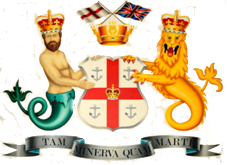Royal Naval College Greenwich Centenary 1873 - 1973

By Wisdom
As Much As War
Introduction
The Royal Naval College at Greenwich was
established by Order in Council in 1873. It took over the magnificent buildings
of the Royal Hospital for Seamen, which had been designed by Wren in 1694 for
William III as a home for aged and sick seamen. The Hospital had housed nearly
3,000 pensioners at its peak (1813) but, with long years of peace and the offer
of money pensions in lieu of residence, numbers had shrunk to under 400.
Administrative costs meanwhile had trebled owing in part to corruption reports
on conditions were not flattering and in 1869 it was closed. The Hospital
Infirmary was not taken over. This was leased to the Seamen's Hospital Society
to replace the old 'Dreadnought' hospital hulk moored in the Thames and in turn
it passed to the Ministry of Health in 1946. The Royal Hospital School for
seamen's sons (which occupied the Queen's House and adjacent buildings) was
carried on by the Foundation till 1933 when it moved to Holbrook in Suffolk.
The Painted Hall and King Charles Block were used as a naval museum until 1937
when a National Maritime Museum opened in the newly vacated and restored
Queen's House. The insides of the Wren buildings have been extensively
remodelled as Hospital was turned into College, but the beautiful exterior has
been preserved unchanged. Now the whole is scheduled as a national treasure
under the Ancient Monuments Act and is maintained jointly by the Ministry of
Defence and the Department of the Environment.
The wish of James
Moncrieff in 1759 has been realised. 'This superb building' said he 'I would
dignify with a use not dreamed of by the contrivers. From the couch and
sepulchre of age, I would change it into the cradle and as it were, the forge
of youthful merit.'
Officer recruitment and training
Officer
entry into the Royal Navy was traditionally restricted to 'sons of officers' or
'sons of noblemen and gentlemen' privately 'nominated' as 'Captain's Servants'
(with a few officially nominated as 'King's Letter Boys'), and all training was
done at sea. The Admiralty had no control over entry or training though it did
attempt to break in on this self-perpetuating closed shop of privilege by
setting up a Naval Academy in Portsmouth in 1729. This first shore training
establishment became the Royal Naval Academy in 1773, and was reconstituted .as
the Royal Naval College in 1806, but its aim of wider entry and higher academic
standards did not attract. Few, and especially few of the great sailors, went
to it and it was closed with no regrets in 1837. In 1838 the Admiralty took
more control by instituting an entrance examination. Farce though it was, it
made rejection possible and when in 1870 'limited competition' was started only
half the would-be entrants need be accepted. Meanwhile general training had
gone back to sea, first in ordinary ships, then from 1857 in 'training ships'
(Illustrious, Britannia). 'Ship' gave way once more to 'College' in 1905 when
Osborne and Dartmouth were set up, and these were merged in 1921 with entry at
age 13. Private 'nomination' ceased in 1913 though 'recommendations' subject to
competition continued. In that year too the Navy moved away from the 'catch em
young' policy by starting the 'Special' or 'Public School' Entry, a tap whose
flow they could conveniently regulate. 13 year-old entry to Dartmouth was
changed to 16 year-old (in 1947) then to 18 year-old (in 1956). And now, to
match a changing world, there are University Cadetships and University Graduate
entry as well as regular and increasing promotions from the lower deck.
Reform for a new age
The advent of steel and steam in the
19th Century made more specialised training necessary and in 1841 a new Naval
College was established in Portsmouth 'to afford additional scientific training
to officers'. This amalgamated with HMS Excellent - the gunnery school founded
in 1832 - but it rapidly deteriorated into a promotion crammer. Traditionalists
'looked upon scientific attainments not so much as a waste of time but
injurious to the acquisition of seamanship and the details of routine.' (2)
However, a School of Naval Architecture and Marine Engineering was opened in
1864 at South Kensington by the Rev J Wooley (a later Director of Naval
Education) undeterred that his first attempt at Portsmouth had lasted only 5
years (1848-53).
|